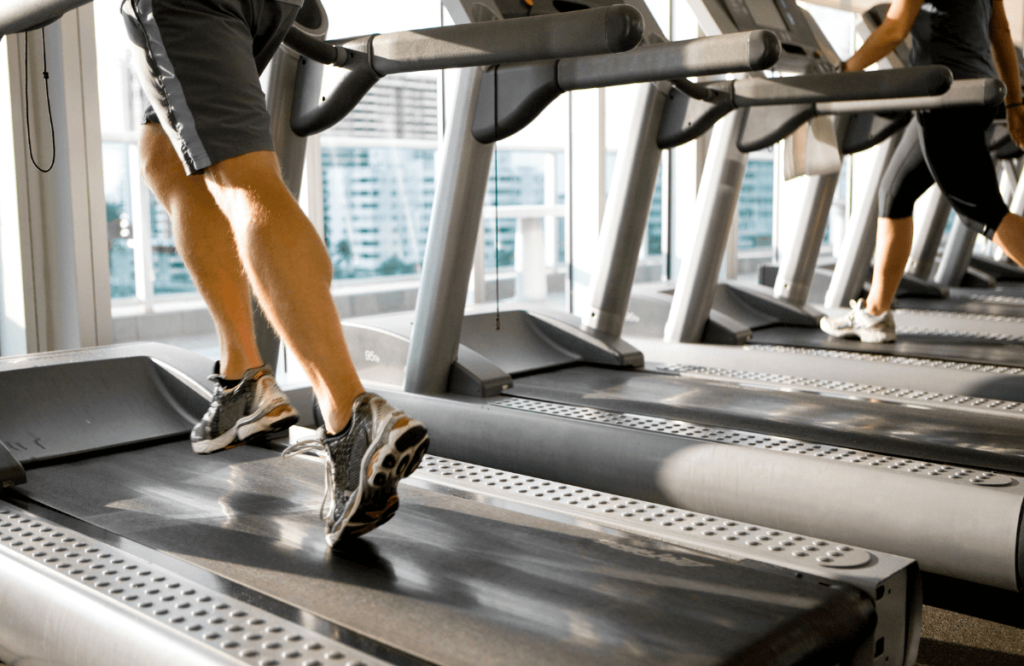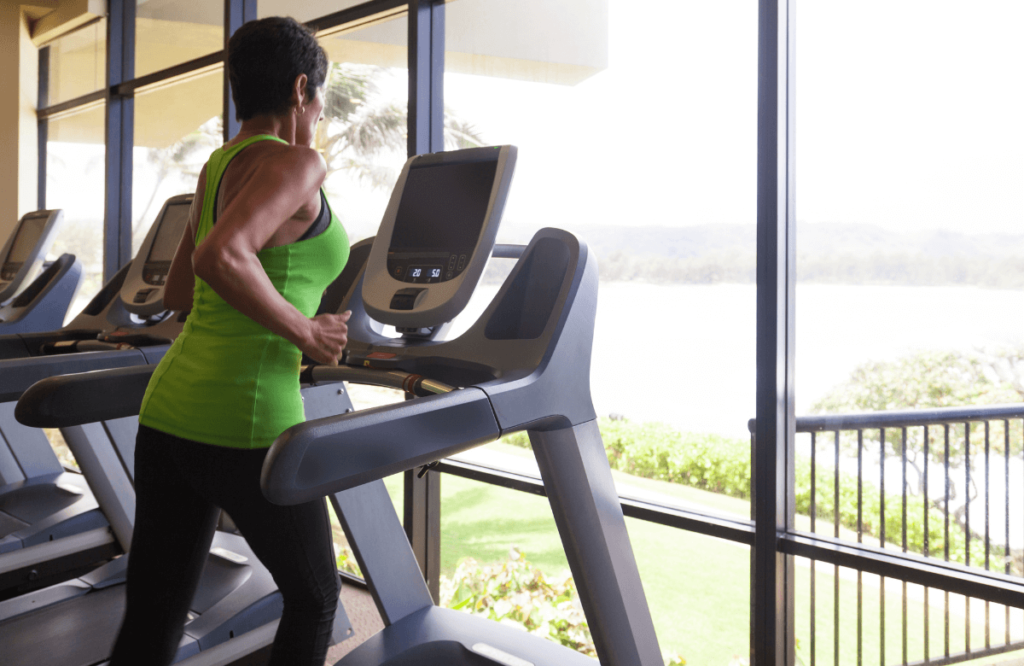Many athletes are excited about running on treadmills. To tell the truth, there is no denying that treadmill machines are great for avoiding bad weather conditions or safety issues, getting a quality workout done, and time efficiency. However, over the years we have seen many long-distance runners that don’t know how to run a treadmill properly.
What is the proper running form on the treadmill? In this article, we are going to be walking you through the right way to run on a treadmill. We mean correct running form, specifically on the treadmill.
Jump to:
- How to Run on a Treadmill Safely
- Starting the Treadmill
- How to Get Off the Treadmill
- How to Use the Incline of the Treadmill
- How to Finish Your Treadmill Workouts
- How to Run on a Treadmill: Common Mistakes
- The Right Way How to Run on a Treadmill
- Our Treadmill Running Tips to Master Proper Form
- How to Run on a Treadmill Machine: FAQs
How to Run on a Treadmill Safely
Every treadmill has a safety feature. When activated, it automatically stops the treadmill. It’s typically located right under the treadmill screen. When you pull the string, the red tab automatically comes out and stops the treadmill. To start the machine again after using the emergency stop, push the red tab again.
Starting the Treadmill
To begin the treadmill, just press the green start button. If you want, you can also start with your feet on the outside of the treadmill first. And then step onto the walking belt once it begins moving.
The treadmill will start at a relatively slow pace. To increase the speed, find the button with a running man on it. For some treadmills, it may be located on the right-hand side. By pushing it forward the speed increases. The more you push it forward, the faster it will go.
Nowadays, most treadmills allow you to plug your headphones in or connect your earbuds via Bluetooth. You should also be able to monitor your speed on the treadmill screen.

How to Get Off the Treadmill
If you want to get off the moving belt right away and don’t want to wait for it to slow down or jump off the treadmill completely, you can just hop on the sides of your treadmill. To slow the treadmill down, just pull the speed tab backward.
Most treadmills have speed buttons with a plus and a minus sign on them. The minus sign will reduce speed and the plus sign will increase it.
How to Use the Incline of the Treadmill
You can adjust the incline of your treadmill. The higher the incline, the more uphill you’ll be walking or running. Some treadmills have the option of a decline. With this feature, you can walk or run downhill.
To adjust the incline, find the button of the man running uphill. For some treadmills, it may be located on the left-hand side. The plus sign will increase the incline, the minus sign will decrease it.
When you increase the incline, you’ll see the bottom of the treadmill slowly tilt upwards. To decrease the incline, simply push the minus sign and it will tilt backward.
You can simply monitor the incline on the treadmill screen.
How to Finish Your Treadmill Workouts
To finish your runs on treadmills, press the pause or stop button located on the treadmill screen. For some treadmills, it’ll ask if you want to stop or restart. You’re going to press stop in order to finish your workout. It’ll then give you an overview of what your workout looks like.
How to Run on a Treadmill: Common Mistakes
1. Crowding the Console
The number one mistake is runners crowding the console. So you might be afraid of falling off the back of the treadmill and that’s why we see runners running super close to the console. It causes an inefficient running form because you don’t open up your stride to your natural running form.
2. Carrying Arms
Also, we sometimes see people carrying their arms while performing their complete treadmill training. That might have to do with running too close to the console. Or whenever you get tired or get fatigued, you start carrying the arms and not using them.

3. Hunching
Another common running form mistake that you can do is as you start getting tired and fatigued, you’re collapsing the chest, you start hunching over, you’re dropping the shoulders, and you’re not running forward anymore.
4. Overstriding
Another common running form mistake is overstriding. We sometimes see instead of those short and quick strides, some overstriding. We mean heel striking and letting the foot strike way in front of you.
5. Looking Down
The last mistake that we want to point out is a lot of indoor competitive runners looking down at the console. We know that we’re counting down the minutes and looking at the pace, but looking down at the console is going to force the chin and chest to drop. As a result, we’re not running tall, proud, and relaxed anymore.
The Right Way How to Run on a Treadmill
So, now we’re going to go the right way. Here is how to become an economical runner.
1. Step Back From the Console
We talked about crowding the console, which leads to a lot of the running form problems that we talked about. So, take half a step back off of the treadmill console. You have a lot more space than you think you have.
2. Relaxed Arms and Driving Elbows
So, to become a faster runner, take half a step off of your console. Now you have no excuse to carry your upper body, other than getting tired, getting fatigued. Here is our following treadmill running tip. You don’t have to carry your arms, drop them down, drop them at your side, and use them for driving those elbows straight back.
3. Arm Swing
We hear a lot that some people recommend keeping our arms no higher than a 90-degree angle. But that’s not the point. Sometimes elite runners keep their arms a little higher or lower than 90 degrees.
The thing is you don’t want to cross arms. You want to have your arm going up and down while your shoulders relax. It’s not rocking. If you feel like you’re stiff even a little bit, just literally shake your shoulders.
Your fingertips are slightly closed. Don’t grip them too much. You want to be efficient because you perform long-run treadmill workouts. It’s a race. It’s not a sprint.
So, your hands are slightly closed but your arms are going up and down, not sideways. The reason you want this is that you’re creating rhythm. When you get this rhythm, it’s the best feeling in the world. Your legs are landing in sync with your arms.

4. Foot Strike in Line With Hips
We also talked about overstriding. If you take a quick peek down at your feet, and you see yourself almost hitting the front of the treadmill, or even overstriding over the top of this treadmill, let’s shorten that stride. You want to think about that foot strike landing directly underneath your hips.
5. Forefoot or Midfoot Landing
While performing treadmill workouts, focus on as if you’re almost going to step over something. That’s going to naturally get you to land on your forefoot. You don’t want a heel strike. Don’t put all the force on the heel because that’s going to slow you down instead of propelling forward.
6. Back Leg
Experienced runners say that using the back leg is helpful. Because if you rapidly lift that up, it gives you momentum to propel you forward. When you’re kicking back, focus on that glute because that’s where your power comes from.
7. Stay Tall
We also talked about looking down at the console and causing yourself to drop your chin and shoulders. Do a quick check-in here. You are rolling the shoulders back, proud, open chest with that gaze straight ahead. You want all of your energy moving straight ahead.
8. Small Strides
While running on a treadmill belt, use small but quicker strides because it’s not a sprint. It’s a marathon. It may feel uncomfortable because this is what your body is not used to. But when you make it a habit, it becomes comfortable and useful.
In order to make it a habit and progress over time, don’t worry about stride count and how fast you can perform your treadmill runs. Small but not choppy strides will also prevent common runner injuries on treadmills.
Our Treadmill Running Tips to Master Proper Form
Here are some tips that can help beginner runners upgrade their treadmill running technique and get lots of benefits:
- Use a mirror to check your posture and your feet;
- Focus on a lighter and softer foot fall;
- Begin with a 1 to 2% incline setting;
- Raise treadmill speed gradually;
- Avoid hanging on to the rails while running;
- Start at a comfortable warmup pace. Warm up your muscles by walking for at least 5 minutes.

How to Run on a Treadmill Machine: FAQs
How should a beginner run on a treadmill?
It’s all about aligning yourself correctly and setting yourself upright. It’s going to be important that you set yourself up like you want to line your throat, sternum, belly, and pelvis all in one line. Don’t jump. Just move forward.
How fast is 7.0 on a treadmill?
If you set 7.0 miles per hour on your treadmill, your pace will equal 8:34-minute miles. Here are equivalent paces by incline:
0% – 8:56 minutes per mile;
1% – 8:32 minutes per mile;
2% – 8:10 minutes per mile;
3% – 7:51 minutes per mile;
4% – 7:34 minutes per mile;
5% – 7:19 minutes per mile;
6% – 7:05 minutes per mile;
7% – 6:53 minutes per mile;
8% – 6:41 minutes per mile;
9% – 6:31 minutes per mile;
10% – 6:21 minutes per mile.














